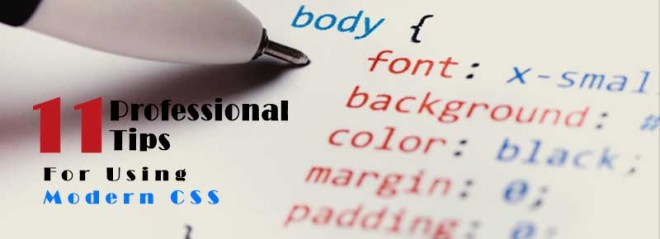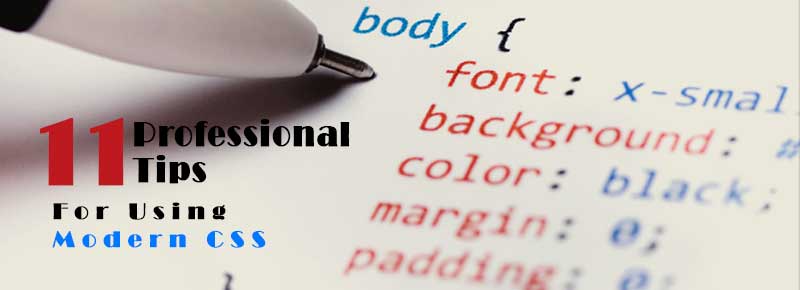11 Professional Tips for Using Modern CSS
In this blog post we intend to show to you a collection of 20 useful conventions and also finest practices that are suggest by the CSS area. Some are customized more to newbies, as well as some are a bit advanced, yet we really hope everyone will certainly find a trendy trick they really did not know about. Delight in!
Beware of Margin Collapse
Unlike most various other residential or commercial properties, vertical margins collapse when they meet. Exactly what this means is that when the bottom margin of one element touches the leading margin of an additional, just the larger of the two makes it through. Right here is an easy instance:
.square {
width: 80px;
height: 80px;
}
.red {
background-color: #F44336;
margin-bottom: 40px;
}
.blue {
background-color: #2196F3;
margin-top: 30px;
}
Instead of 70px between the red and blue square we have just 40px, the margin of the blue square isn’t taken into consideration whatsoever. There are means to battle this habits, however it’s far better to simply work with it and also use margins just entering one instructions, ideally margin-bottom.
Usage Flexbox for Layouts
The flexbox model exists for a reason. Floats and also inline-blocks work, yet they are all basically tools for styling files, not websites. Flexbox on the other hand is particularly developed to earn it very easy to develop any kind of layout precisely the method it was envisioned.
The collection of properties that have the flexbox version give designers great deals of adaptability (no pun meant), as well as once you obtain utilized to them, doing any type of receptive layout is a breeze. Web browser support nowadays is almost excellent, so there shouldn’t be anything quiting you from going full flexbox
.container { display: flex; /* Don’t forget to add prefixes for Safari */ display: -webkit-flex;}
We have actually showcased a variety of tips as well as technique with flexbox prior to on Tutorialzine. You could check them out here: 5 Flexbox Strategies you should understand about.
Do a CSS Reset
Although the situation has substantially boosted over the years, there is still plenty of variation in the means various internet browsers act. The very best way to solve this problem is to apply a CSS reset that sets global default worths for all elements, allowing you to begin dealing with a tidy style sheet that will produce the exact same outcome all over.
There are libraries like normalize.css, minireset, and also ress that do this effectively, dealing with all conceivable internet browser inconsistencies. If you don’t wish to make use of a collection, you can do an extremely basic CSS reset on your own with these styles:.
* { margin: 0; padding: 0; box-sizing: border-box;}
This might appear a little bit rough, yet nullifying margins and cushionings really makes laying out elements a lot easier as there are no default spaces in between them to take into consideration. The box-sizing: border-box; building is an additional good default, which we will certainly speak about more in our following pointer.
Border-box for all.
A lot of newbies do not know about the box-sizing property however it’s actually quite crucial. The most effective method to understand just what it does is to take a look at it’s two feasible values:-
- content-box (default)- When we established a width/height to a component, that’s simply the dimension for it’s content. All extra paddings as well as boundaries get on top of that. E.g. a <div> has a size of 100 as well as cushioning of 10, our component will take up 120 pixels (100 + 2 * 10).
- border-box- The cushioning and boundary are consisted of in the width/height. A <div> with width: 100px; as well as box-sizing: border-box; will certainly be 100 pixels broad no matter what extra paddings or boundaries are added.
Setting border-box to all elements makes it a lot easier to design whatever, since you do not have to do mathematics constantly.
Photos as Background
When adding images to your design, specifically if it’s going to be receptive, use a <div> tag with the history CSS residential property as opposed to <img> elements.
This may appear like more work for absolutely nothing, yet it actually makes it a lot easier to style images appropriately, maintaining their original size as well as aspect-ratio, thanks to background-size, background-position, and also other homes.
img {
width: 300px;
height: 200px;
}
div {
width: 300px;
height: 200px;
background: url(‘http://cdn.tutorialzine.com/wp-content/uploads/2016/08/bicycle.jpg’);
background-position: center center;
background-size: cover;
}
section{
float: left;
margin: 15px;
}
A downside of this method is that the web access of your page will certainly take a slight hit, as photos won’t be crept properly by screen visitors and also online search engine. This concern can be dealt with by the amazing object-fit but it does not have complete browser assistance yet.
Better Table Borders.
Tables in HTML are not enjoyable. They are wacky, practically impossible to be made receptive, and also overall tough to design. As an example, if you intend to include basic borders to your table as well as its cells, you will certainly most likely wind up with this:.
table {
width: 600px;
border: 1px solid #505050;
margin-bottom: 15px;
color:#505050;
}
td{
border: 1px solid #505050;
padding: 10px;
}
As you can see, there are rather a lot of duplicating borders almost everywhere and also it does not look great. Below is a fast, hack-free means to remove all increasing boundaries: merely add border-collapse: collapse; to the table.
table {
width: 600px;
border: 1px solid #505050;
margin-bottom: 15px;
color: #505050;
border-collapse: collapse;
}
td{
border: 1px solid #505050;
padding: 10px;
}
Compose Better Comments.
CSS could not be a programming language yet it’s code still needs to be recorded. Some simple comments are all it requires to arrange a design sheet and make it a lot more easily accessible to your associates or your future self.
For larger areas of the CSS such as major elements or media-queries, utilize an elegant comment as well as leave a number of brand-new lines after:.
/*————— #Header—————*/header { } header nav { } /*————— #Slideshow—————*/.slideshow { }
Details with less components can marked by this comment code:-
/* Footer Buttons */.footer button { } .footer button:hover { }
Additionally, bear in mind that CSS does not have single line// comments, so when commenting something out you still need to make use of the/ * */ syntax.
/* Footer Buttons */.footer button { } .footer button:hover { }
Every person Loves kebab-case.
Course names and also ids need to be written with a hyphen (-) when they consist of a lot more after that one word. CSS is case-insensitive so camelCase is not a choice. A very long time earlier, highlights used to not be sustained (they are now) makinged dashboards the default convention.
/* Footer Buttons */.footer button { } .footer button:hover { }
When it involves calling, you could also take into consideration BEM, which follows a set of concepts that add consistency and also provide a component-based technique to advancement. You can learn more about it in this superb CSS-Tricks article.
Don’t Repeat Yourself.
The worths for a lot of CSS residential properties are inherited from the component one level up in the DOM tree, for this reason the name Cascading Style Sheets. Allow’s take the typeface residential property as an example– it is usually acquired from the moms and dad, you do not have to establish it once more independently for each and every and also every aspect on the page.
Simply include the font styles that will be most common in your design to the <html> or <body> aspect and let them flow down. Here are some excellent defaults:-
html { font: normal 16px/1.4 sans-serif;
}
Later on you could always change the styles for any kind of provided component. Exactly what we are stating is just to avoid repetition and use inheritance as much as feasible.
CSS Animations with transform.
Do not stimulate components by straight changing their width and also height, or left/top/bottom/ right. It’s preferred to utilize the transform () residential property as it provides smoother transitions and makes your objectives easier to comprehend when checking out the code.
Below’s an example. We intend to animate a sphere and slide it out to the right. Rather than altering the value of left, it’s better to make use of translateX():
ball { left: 50px; transition: 0.4s ease-out;} /* Not Cool*/.ball.slide-out { left: 500px;} /* Cool*/.ball.slide-out { transform: translateX(450px);}
Transform, as well as all of its several functions (translate, rotate, scale, etc.) have nearly universal browser compatibility and also can be used freely.
Em, Rem, as well as Pixel.
There is a great deal of discussion whether individuals need to use em, rapid eye movement, or px values for setting the dimension of aspects and text. Fact is, all three choices are practical and have their benefits and drawbacks.
All developers and tasks are different, so there can’t be any type of strict rules on when to utilize which. Here are, however, some tips and also basic excellent methods for every device:-
- em– The value of 1 em is about the font-size of the straight parent. Typically utilized in media-queries, em is wonderful for responsiveness, yet it can obtain actually complicated mapping back the currency exchange rate of ems to pixels for each element (1.25 em of 1.4 em of 16px =?).
- rem— Relative to the font-size of the <html> aspect, rem makes it really simple to scale all headings as well as paragraphs on the page. Leaving the <html> with it’s default font-size and also establishing every little thing else with rapid eye movement is a great method accessibility-wise.
- px– Pixels give you one of the most precision however don’t supply any kind of scaling when made use of in responsive styles. They are reputable, understandable, as well as offer an excellent visual link in between worth and also actual outcome (15px is close, maybe just a pixel or two even more).
Profits is, do not hesitate to experiment, attempt them all and see exactly what you such as best. In some cases em and also rem can saves you a lot of work, especially when building receptive web pages.


